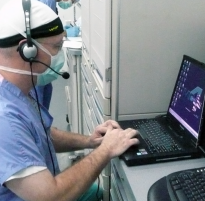Telehealth programs for neonatal resuscitation were associated with a reduction in transfers from hospitals without newborn intensive care units, a reduced transfer risk and an increase in community hospital revenue, according to a study published in Health Affairs.
For the study, researchers examined data from Salt Lake City-based Intermountain Healthcare on eight community hospitals that implemented video-assisted resuscitation between November 2014, and December 2015, to level 3 newborn intensive care units.
The study found neonatal telehealth reduced transfers from hospitals without newborn intensive care units at a rate of 0.70 per facility per month and was associated with a 29.4 percent reduction in a newborn’s risk of being transferred.
Study authors said this corresponded to 67.2 fewer transfers annually at the eight hospitals studied and projected savings of $1,220,352 annually, based on an average cost of $18,160 per air medical transfer.
“Avoiding transfers keeps families closer to home, increases community hospital revenue and eliminates transfer-associated risk,” the authors concluded. “Yet lack of reimbursement for telehealth limits its adoption. Policy changes are necessary to align payment incentives and promote the use of telehealth services.”

